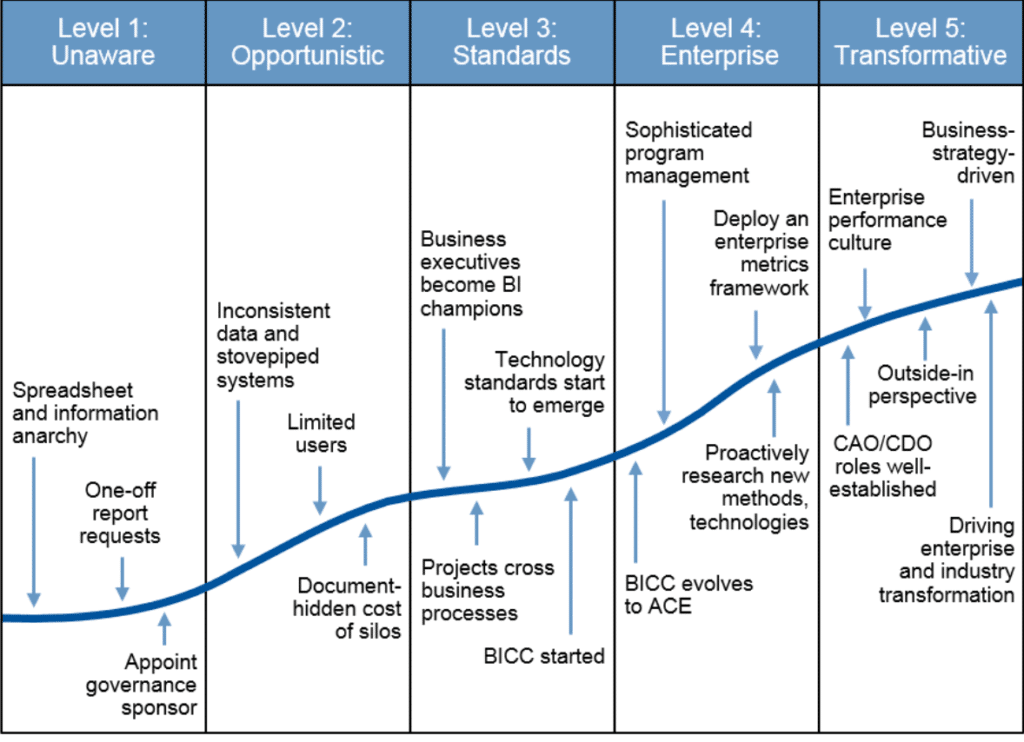#BI
No matter the size of your company, be it a start-up or a big corporation, neglecting the power of applying advanced analytics to your data could mean setting yourself up for failure.
In this article we are going to explain the typical steps that companies go through to reach a stable and effective predictive analytics implementation. This can also help in determining where your company’s currently at in the adoption of business analytics, and what the next steps are in evolving your BI strategy on your journey to becoming a data-driven company.
BI Maturity Model
There are several BI maturity models, although the most well-known one is Gartner’s BI maturity model. Take a look at the diagram and you can quickly figure out where your company sits. Do you have a centralized, homogeneous data repository that all departments can access? Or is your data still siloed in different departments, each one having their own version of the truth?

In the next section, we’ll have a look at the main steps in the BI model adoption and their characteristics.
Step 1: Ad Hoc Reporting using BI
This is the first step in the adoption of a company-wide BI strategy. Data is siloed in each department, so different users can have different versions of the truth. Reports are usually developed using Excel spreadsheets and data is sometimes stored in local databases, and users rely heavily on IT experts for report creation.
Step 2: Consolidation and Analysis
One of the most important steps in creating a data-driven company is having a single source of truth. The BI team now has financial sponsorship from the company managers to create a centralized data warehouse where all the data will be stored in a homogeneous and structured way. Departments can now use the data in the data warehouse or create data marts that feed from the data warehouse to create reports from a single source of truth. Semantic layers can be put in place to allow users easy access to the data in the data warehouse. Business users can now use self-service BI solutions to create their own reports without the help of IT experts, leaving them more time to improve the data model and work on advancing the company’s analytics implementation.
Step 3: Monitoring
Dashboards and scorecards are created to aggregate data at a high level and monitor the current state of the business. Decision makers now have easy access to the current and past status of the company, and are empowered to make more informed decisions. At this stage, business users can see the value of having a solid BI strategy and trust the data and dashboards put in place, considering them a main asset and an intrinsic part of the company. If slowly changing dimensions (SCD) are implemented, these dashboards would be living boards aggregating real time intelligence. They can easily see the cause and effect of their actions and perform rigorous data-driven approaches to drive changes in the business. The company can be now considered a “Data Driven” company.
Step 4: Predictive Analytics with BI
At this stage predictive analytics is implemented in the company, so users can now answer “what will happen?” questions and not only “what happened?”. The company now has an advantage over its competition, as they can react in advance to anticipated market changes. At this point, data insights are critical to the business decision making process. Artificial Intelligence and Machine Learning algorithms are applied to business data to extract predictions and empower users to make better-informed decisions.
Where is your company on the road to Predictive Analytics?
Most companies lie between a consolidation and analysis/monitoring stage, but taking the plunge to invest in a predictive analytics model can be the key to unlock the competitive advantage your company needs. Here is a list of different areas you could leverage BI for your company’s success.
Richard Goodman is Senior BI and Data Analytics Engineer at Zartis. For more information on the topic above, reach out to sayhello@zartis.com. Zartis Digital empowers companies to build outstanding software. Our services include Remote Teams, Software Development and Technology Advisory.


